Wetsuits and Drysuits for Kiteboarders: A Complete Guide
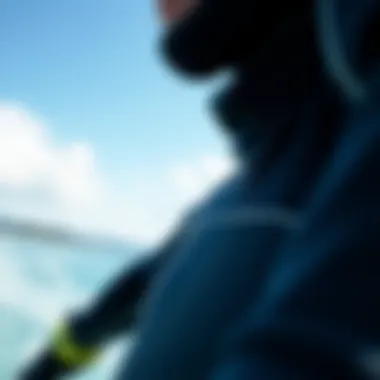
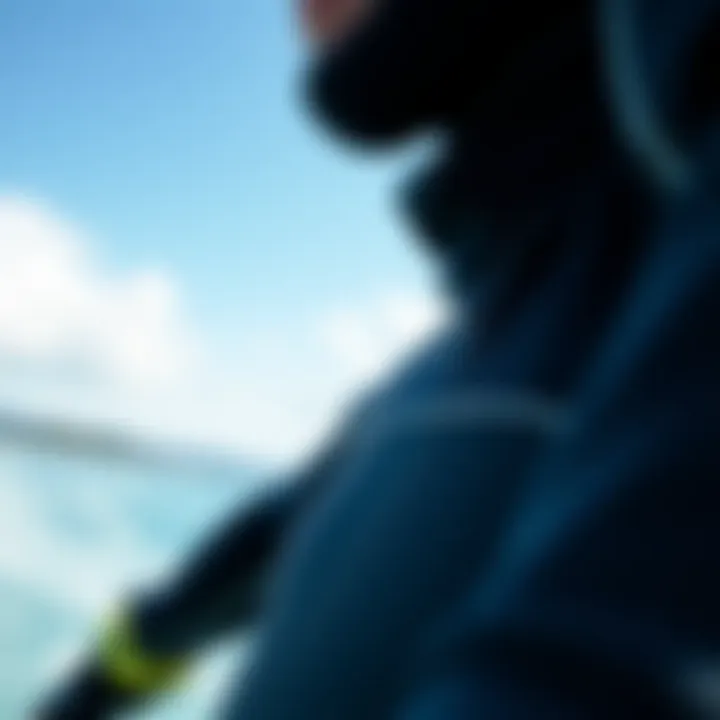
Intro
When it comes to kiteboarding, the right gear can make all the difference. Among the essential pieces of equipment are wetsuits and drysuits, which play a crucial role in enhancing your comfort and performance on the water. Understanding the features and functions of these suits isn’t just for the pros; every kiteboarder—whether a novice or seasoned rider—should grasp how to pick the best option for their needs.
In this article, we will embark on a deep dive into the world of wetsuits and drysuits, emphasizing their significance in various water conditions where kiteboarding takes place. We’ll look into the construction of these suits, what makes them tick in different temperatures, and how they can impact your riding experience. Additionally, you’ll gain insights into the nitty-gritty of choosing the right fit, maintaining your suit for longevity, and squeezing out the best performance from your gear. So, buckle up, as we unravel the essentials that every kiteboarder should know.
Understanding Wetsuits and Drysuits
In the realm of kiteboarding, having the right gear isn't just about style or brand prestige; it's about performance and comfort in diverse conditions. This emphasizes the necessity of understanding the fundamental roles that wetsuits and drysuits play for kiteboarders. Without a proper grasp of these essential pieces of apparel, enthusiasts might find themselves battling discomfort or even risking safety in changeable weather and water conditions.
When kiteboarding, the elements might be against you. Wind might whip up unexpectedly, and water temperatures can drop like a stone. Herein lies the cornerstone of this article—an exploration of how wetsuits and drysuits cater to the safety and comfort of the rider. By delineating their unique functionalities, features, and applications, this guide hopes to equip kiteboarders with insights necessary for making informed decisions.
Consider the difference in water temperatures as one navigates between different locations. A wetsuit might keep you snug in milder waters, allowing for flexibility and ease of movement, while a drysuit, with its waterproof shell, could be a lifesaver during those chillier days when the cold could cut straight to your bones. Each suit serves a distinct purpose and must be chosen according to the specific conditions expected on a given day. KItboarders, therefore, have to factor in both their personal preferences and the nature of their surroundings.
The aim here is not just to describe what these suits are but to dive into their actual purpose and utility based on various contexts kiteboarders face. Keeping this in mind, let’s first break down what wetsuits are meant to do.
Definition and Purpose of Wetsuits
Wetsuits are crafted primarily to provide thermal insulation while also offering some level of buoyancy. Using materials like neoprene, they trap a thin layer of water between the suit and the skin. This water warms up through body heat, forming a thermal barrier. This feature is crucial, especially in cooler waters where prolonged exposure can lead to hypothermia. The flexibility they offer is nothing to frown upon either; it allows for a full range of movement essential for maneuvers on the water.
Moreover, wetsuits help keep the body streamlined, enhancing performance by reducing drag. They come in various thicknesses, catering to different temperature ranges, and are available in short, long, and full suit designs. Depending on the water temperature, a kiteboarder might opt for a thinner suit in tropical climates or a thicker option when venturing into chillier territory.
Notably, the fit of a wetsuit is paramount. A snug fit without being restrictive ensures that the body retains warmth while also allowing the rider to feel at ease moving with the flow of the water.
Definition and Purpose of Drysuits
Unlike wetsuits, drysuits offer a completely different level of water protection and temperature management. These suits are designed to keep the wearer entirely dry, which is of utmost importance in frigid waters. Made from waterproof materials, typically a blend of nylon and rubber, drysuits maintain a barrier against the elements, effectively preventing water entry.
Drysuits are fitted with seals around the neck, wrists, and ankles, ensuring that no water seeps in during activity. This makes them especially valuable for cold water environments where immersion could lead to serious consequences. Additionally, drysuits often come with insulation layers, keeping warmth locked in without the worries of the suit becoming overly cumbersome or restrictive.
Another handy aspect of drysuits is their versatility. Many models are designed to be worn over thermal garments, allowing wearers to adapt to different temperature conditions by simply adjusting their under layers. The ability to fine-tune insulation according to the climate is a defining feature for kiteboarders navigating varying conditions.
In summary, the distinction between wetsuits and drysuits can't be overstated. Understanding what each suit offers leads to better-informed decisions, ensuring that kiteboarders remain comfortable and safe regardless of the circumstances they face on the water. As we transition to exploring the construction materials of these suits, it's essential to remember how these choices affect both performance and rider experience.
Construction Materials
Understanding the materials that make up wetsuits and drysuits is essential for kiteboarders who prioritize performance and comfort in their gear. The choice of construction materials not only impacts how well these suits keep the body regulated against water temperature but also influences the suit's longevity and durability in the oftentimes harsh aquatic environments kiteboarders face.
Neoprene in Wetsuits
Neoprene is virtually synonymous with wetsuits, serving as the foundational material for many designs. This synthetic rubber, known for its insulation properties, provides a comfortable barrier against cold waters. The thickness of neoprene varies, usually ranging from 2mm to 5mm, accommodating warm seasons to frigid waters. The thicker the neoprene, the more insulation it offers, but there are trade-offs in flexibility and ease of movement.
Benefits of Neoprene include:
- Thermal Insulation: Neoprene traps a thin layer of water against the skin, which warms up from body heat, creating an insulating effect.
- Flexibility: High-quality neoprene allows for fluid movements, critical for performing maneuvers in kiteboarding.
- Durability: Modern neoprene blends have proven resistant to wear and UV exposure, increasing the lifespan of the suit.
While neoprene reigns supreme, other options exist, like limestone-based neoprene which boasts a lower environmental impact. This alternative retains similar thermal properties but utilizes a more sustainable approach in its production process, aligning with the values of eco-conscious kiteboarders.
Drysuit Fabrics
Drysuits diverge from wetsuits by employing various types of fabrics designed primarily for insulation and waterproofing. The most common materials found in drysuit construction are breathable membranes, commonly constructed of materials like Gore-Tex, which offer the following characteristics:
- Waterproofness: Drysuit fabrics create a barrier against external water, keeping the user completely dry.
- Breathability: Advanced drysuit fabrics allow moisture from the body to evaporate, reducing sweat accumulation inside the suit. This is crucial in preventing discomfort during prolonged kiteboarding sessions.
- Resistance: High-quality drysuit fabrics withstand abrasions and punctures, which can often result from encounters with errant gear or rough surfaces.
In addition to Gore-Tex, other materials such as trilaminate and neoprene/neoprene hybrid options are increasingly popular among serious kiteboarders. Trilaminate suits offer lighter weight and enhanced flexibility, making them appealing for athletic performance, while hybrids can provide an optimal blend of insulation and waterproofing in various conditions.
Choosing the right construction materials directly impacts a kiteboarder's experience on the water. Understanding these details forms a foundation for making informed decisions about which wetsuit or drysuit aligns with your environmental conditions and personal preferences.
"Selecting the right material can feel like finding a needle in a haystack, but it’s the key to butterflying through a perfect day on the water."
By delving into this aspect of wetsuits and drysuits, kiteboarders can elevate their experience, leading to better performance, comfort, and longevity of their chosen gear.
For further insights, consider exploring resources on Wikipedia and Britannica for a deeper understanding of materials used in wetsuit and drysuit construction.
How Wetsuits Work
Understanding how wetsuits function is crucial for kiteboarders aiming to maximize their performance while staying comfortable in varying water temperatures. The right wetsuit can not only enhance buoyancy but also serve as protection from the elements, making a world of difference during a long day on the water. Kiteboarding requires a balance of agility and warmth, and a well-informed choice about wetsuits can significantly contribute to this balance.
Thermal Regulation
Wetsuits primarily work by trapping a thin layer of water between the suit and the wearer’s skin. As you embark on your thrilling kiteboarding adventure, your body heats this trapped water, creating an insulating layer that helps keep your core warm. This thermal regulation is especially critical when you find yourself zipping across colder waters.
- Thickness Matters: Wetsuits come in varying thicknesses, typically ranging from 2mm to 7mm. A thicker suit provides more insulation and is better suited for colder conditions, while a thinner suit offers flexibility and mobility for warmer water.
- Fit is Key: A snug fit ensures minimal water exchange. If the wetsuit is too loose, cold water may continuously rush in, rendering the thermal benefits ineffective.
Choosing the right thickness and fit, therefore, greatly impacts your comfort and performance. For instance, a kiteboarder in the chilly North Atlantic might opt for a 5mm wetsuit with a flush-cut neck to minimize water entry, while someone enjoying the balmy shores of the Caribbean could be comfortable in a 2mm version that allows for a greater range of movement.


Water Entry and Exit
Another vital aspect to consider is how wetsuits manage water entry and exit. A well-constructed wetsuit allows a small amount of water to seep in while also expelling it effectively.
- Sealed Designs: Many modern wetsuits feature sealed seams which are designed to prevent water from entering. The reduced water exchange allows for better thermal insulation, keeping you warmer longer.
- Flush Options: Some suits include features like ankle and wrist seals that can be tightened to reduce the amount of water that might enter during a fall or wipeout, common scenarios when kiteboarding.
- User-Friendly Exit: The design of the suit’s zipper system plays a critical role in how easily you can exit. A well-placed zipper can make all the difference when you want to get out of the suit quickly after a session.
In summary, understanding thermal regulation and water management in wetsuits enables kiteboarders to choose the right gear for their adventure. The sophistication of the design not only enhances comfort but also ensures that kiteboarders can focus on their performance rather than temperature fluctuations. For further insight into thermal technologies in wetsuit design, it’s worth checking resources on the topic such as Wikipedia.
"The right wetsuit doesn’t just keep you warm; it keeps you in the zone where you can focus on your ride."
As you prepare for the next kiteboarding season, considering these elements will equip you with the knowledge necessary to select the perfect wetsuit, ultimately contributing to a better on-water experience.
How Drysuits Work
Drysuits play a crucial role in maintaining comfort and safety for kiteboarders, especially in colder waters. Understanding how these suits function helps enthusiasts make informed choices about their gear. Unlike wetsuits, which allow for some water to enter and be warmed by body heat, drysuits create a barrier that keeps water completely out. This feature is fundamental when you’re looking to stay warm and dry during extended sessions on the water. Key elements of how drysuits operate include waterproof seals, zippers, ventilation, and insulation, each contributing to performance and user experience.
Waterproof Seals and Zippers
When it comes to drysuits, waterproof seals and zippers are non-negotiable for optimal water protection. They’re designed to be watertight, ensuring that the suit can withstand the pressures of various water activities.
Importance of Seals
The seals on the wrists, neck, and ankles often use latex or neoprene materials. These are critical to maintaining dryness. A snug fit is essential; this prevents water from sneaking in and potentially ruining your experience.
Zippers that Keep You Dry
The zippers themselves are also specialized. Look for options like waterproof zipper designs or flap-protected zippers. These help in further sealing off any chance of water getting in.
- Benefits of Good Seals and Zippers
- Prevent water from entering the suit, keeping you warm.
- Offer a layer of security against cold winds.
- Enhance comfort by providing a snug fit.
Drysuit zippers can sometimes be tricky. It's important to familiarize yourself with how they operate to avoid any future mishaps. Regular checks can ensure that the zippers are in working order. Neglecting this could cause them to break or fail at the most inconvenient times.
Ventilation and Insulation
Ventilation is a key feature that separates high-quality drysuits from the rest. It may seem counter-intuitive, but adequate ventilation can significantly enhance comfort and performance.
Insulation and Breathability
Many drysuits now incorporate advanced materials that offer both insulation and breathability. This is important because it can get pretty toasty inside the suit when you’re putting in some serious work on the water.
- Neoprene layers can keep you warm, while breathable fabrics allow heat and sweat to escape.
Control Your Temperature
Some suits come with adjustable vents, allowing you to control the temperature inside the suit. This flexibility can be a lifesaver on those warmer days, where overheating could become an issue. Having that level of temperature regulation can mean the difference between an enjoyable kiteboarding session and an uncomfortable one.
"A drysuit that fits well and manages ventilation effectively is worth its weight in gold on a chilly day out in the waves."
Comparing Performance
Performance is the name of the game in kiteboarding, where the right gear can make or break your experience on the water. Understanding how wetsuits and drysuits stack up against each other in various scenarios is essential for kiteboarders who want to maximize their enjoyment and safety. Choosing between these two options involves scrutinizing several factors, such as thermal protection, flexibility, and water conditions, which can dramatically affect your performance and comfort.
Wetsuits in Different Conditions
Wetsuits shine in specific environments, functioning best in warmer waters or mild temperature climates. When you slide into a wetsuit, you’re embracing a second skin that traps a thin layer of water against your body. Alright, that water feels cold at first, but your body warms it up pretty quick, providing crucial insulation. This feature is particularly beneficial in summer weather or during spring and fall days when temperatures can fluctuate.
A common scenario involves heading out on a sunny afternoon at your local lagoon. The sun casts a warm glow, and the breeze is soft. A 3/2mm wetsuit—either short or long-sleeved—is often just what the doctor ordered. It gives you the warmth you need without feeling like you’re dragging a stone anchor behind you. In contrast, when faced with unexpected unseasonably cold gusts, one might find that a thicker wetsuit, like a 5/4mm, becomes necessary to avoid shivering and discomfort.
However, let’s not gloss over the potential pitfalls of wetsuits. Water can seep in through seams or zippers, and once that happens, it can turn your fun day into a battle against the chill. Additionally, if you’re spending a lot of time in the water doing tricks, the limited entry and exit of cold water can cause a slow-down in body warmth.
Drysuits Versatility
Drysuits present an entirely different kettle of fish. Known for their structural integrity, they keep you completely dry—hence the name. This can be a game-changer in colder and more turbulent waters. Think about a blustery day at your local kite spot, where the wind puts a chill in your bones and the water teeters on the edge of being frigid. Here, a well-fitted drysuit takes the crown.
Ventilation is an area where modern drysuits have taken great strides. With clever designs integrating breathable fabrics, they allow for moisture to escape, which is a double win during a spirited session. If you’re out for longer periods, the ability to regulate your temperature while staying completely dry is invaluable. By the time you're done, you’ll likely be pleasantly surprised at how comfortable you feel.
In summary, both wetsuits and drysuits bring unique benefits to the table for kiteboarding. Each option has its place, and your choice will depend significantly on the specific conditions you face, as well as what feels right for you personally. Whether you're feeling the warmth of the summer sun or battling the brisk autumn winds, knowing how each suit performs can unlock the potential for exhilarating kiteboarding experiences.
Getting the performance right with your suit can mean the difference between an exhilarating day on the water and a cold, regretful one.
Selecting the Right Suit
Choosing the right wetsuit or drysuit is no minor task; it’s akin to selecting the right tool for a job where comfort and performance both play huge roles. When kiteboarding, the right suit can mean the difference between enjoying the thrill of gunning across water and barely making it through a chilly session. Getting this aspect right can unroll plenty of benefits, particularly for kiteboarders who wish to optimize their experience.
Fit and Sizing Considerations
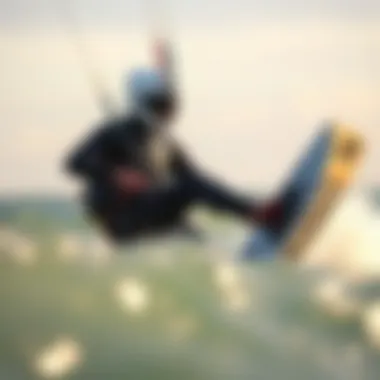
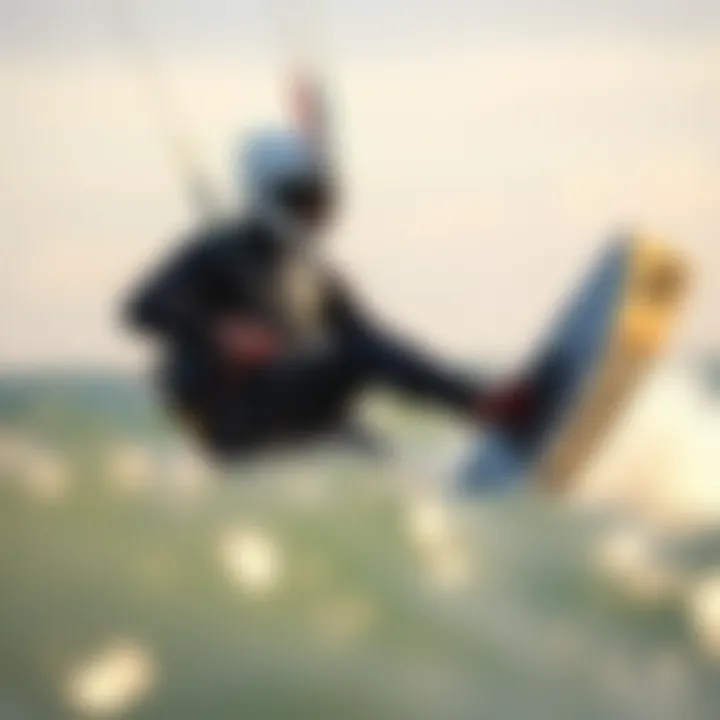
Firstly, let’s dive into fit and sizing. A suit that fits like a glove will offer maximum protection and thermal efficiency, while a loose one might as well be an expensive floatation device. Here are some key points to consider:
- Measurement Accuracy: Spend some time taking precise measurements of your body. Circumference of chest, waist, and hips; inseam; and height should all come into play. Get a friend's help for those awkward angles.
- Try Before You Buy: If possible, try on various brands, as sizing can differ vastly. A medium in one make may not match up to another's. It’s worthwhile to know how each brand fits your body shape.
- Flexibility and Range of Motion: Ensure that your arms can move freely, as if you are stretching for a high-five. A snug fit doesn’t have to compromise your range of motion; the right suit offers both comfort and maneuverability.
- Layers and Comfort: If you plan on layering thermal gear, consider that when choosing sizes. Putting on an extra base layer requires a bit more room.
In sum, a proper fit should be snug but not suffocating. You want to be warm, retain body heat yet keep moving like a well-oiled machine.
Age and Activity Level Factors
Then there’s the age and activity level factor, which shouldn’t be taken lightly. The reality is that not all suits cater equally, so it pays to think ahead:
- Age Considerations: Younger kiteboarders tend to deal better with colder water. If you’re somewhat seasoned in years, find a suit that prioritizes thermal insulation. So, whatever your age, do not skimp on the warmth.
- Activity Level: Evaluate how you’ll be using the suit. If your kiteboarding sessions are high-energy and frequent, opt for something robust with great flexibility. If you’re more on the leisurely side, a simpler suit might cut it.
- Quality Versus Cost: Pay attention to the trade-off between quality and the price point. A higher initial investment in quality gear can lead to greater durability and performance over time, which can be especially important for more seasoned practitioners.
Finding the right balance between these considerations can significantly elevate a kiteboarding session. Each element plays a role that can’t be overlooked. In the end, it’s about being fully prepared to take on the waves, regardless of whether you’re catching wind for the first time or looking to improve your aerial maneuvers.
Maintenance and Care
In the world of kiteboarding, having the right suit is only part of the equation. Just like any other sporting gear, both wetsuits and drysuits require proper maintenance and care to ensure longevity and retain their functionality. Neglecting this vital aspect might lead to compromised insulation, deteriorating material, and reduced performance when it matters most. Thus, understanding how to maintain your gear is crucial for every kiteboarder.
Wetsuit Care Practices
Caring for a wetsuit entails more than tossing it in a corner after a session. Here are key practices that can extend its life:
- Rinse After Use: Always rinse your wetsuit thoroughly with fresh water after using it in the ocean. This practice helps eliminate salt, sand, and chlorinated water residue that can degrade the material over time.
- Drying Right: Hang your suit to dry inside out in the shade. Avoid direct sunlight, which can warp the neoprene over time. Using a hanger specifically designed for wetsuits can prevent unnecessary stretching and damage.
- Storage Matters: When you're not using your wetsuit, store it flat or rolled up, but not hanging on a standard hanger. This reduces stress on the material and prevents deformation.
- Inspect for Damage: Regularly check for tears, frays, or punctures. If you spot any minor issues, getting them repaired promptly can prevent bigger problems down the line.
Taking these precautions will not only help maintain the suit’s performance but also keep it comfortable for your next ride.
Drysuit Maintenance Techniques
Drysuits, while they might look more complex, have their own set of maintenance protocols.
- Clean Carefully: Just like wetsuits, drysuits should be rinsed after every use, focusing on the openings and seals, since these areas are often prone to salt and dirt build-up.
- Seal Inspection: Regularly check the gaskets and zip areas for wear and tear. These seals are what keep you dry; any damage here could lead to leaks.
- Zipper Care: Apply a zipper lubricant periodically to ensure it moves smoothly. A stiff zipper can lead to accidental tears or full zipper failure.
- Store Properly: Similar to wetsuits, drysuits should be stored hung up, preferably with a wide-shouldered hanger to maintain the shape. Make sure it’s completely dry before storage to avoid mildew growth.
By following these maintenance techniques, you can ensure that your drysuit will continue to provide reliable protection against the elements. Careful attention to details not only enhances your safety but also maximizes the investment you've made in your gear.
"A well-maintained wetsuit or drysuit is like a faithful companion; it enhances your ride and offers you protection when the elements try to knock you down."
For further reading on proper care and maintenance, consider visiting Wikipedia on Wetsuit Care and other related resources such as Britannica or your local kiteboarding forums on Reddit.
Making sure your gear is well taken care of can be the difference between an enjoyable kiteboarding experience and a frustrating one. Engage in diligent maintenance practices to keep your wetsuits and drysuits up to par.
Cost Considerations
When shopping for wetsuits and drysuits, understanding the costs is crucial. These aren't your average clothing items; they are investments into safety, comfort, and performance out on the water. Especially for kiteboarders, a suit can significantly impact every ride. Therefore, delving into the financial aspect is just as important as knowing about the technical specifications.
Buying either suit involves analyzing several elements, including materials, brand reputation, and technology features. Let's break down the two categories:
Price Range of Wetsuits
Wetsuits come in a range of prices, often dictated by thickness, materials, and brand innovation. Generally, you can find basic wetsuits starting around $100-150. These typically have less advanced features but are suitable for beginners still finding their groove in the sport.
Mid-range options, priced between $200 and $400, often feature higher-quality neoprene, enhanced durability, and improved thermal efficiency. Think of them as your reliable workhorse—good enough to provide solid performance without breaking the bank.
If you’re looking for top-of-the-line suits, expect to fork out anywhere from $500 to over $800. These wetsuits are often made from the latest materials designed to stretch better, dry quicker, and resist wear and tear from the relentless saltwater. Brands like Rip Curl and Xcel push the envelope in technology, so their premium pricing makes sense considering the potential performance gains.
Investing in a quality wetsuit can often mean fewer issues down the line. You may save money by not having to replace a cheaper suit repeatedly.
Considering what you want from the suit is paramount. Factors such as water temperature, duration of use, and even your skill level can all bear weight on how much you should realistically invest.
Drysuit Investment Analysis
Now, when it comes to drysuits, prepare for a different set of costs. Generally, drysuits are on the higher end of the pricing spectrum because they're engineered for specific conditions. Entry-level options can start around the $600 mark but don’t be surprised to see more advanced suits marketed at prices exceeding $1,500.
What exactly do you get for your money? Well,
- A well-constructed drysuit offers better waterproofing, ensuring that not a drop of water sneaks in.
- They often come equipped with insulation layers, making them reliable for those chilly sessions.
- The longevity of a drysuit can also be higher, as many are designed to withstand years of rigorous use in demanding environments.
While the initial cost may seem steep, consider the type of conditions you'll encounter. If extreme temperatures and prolonged exposure to the elements are your thing, splurging on a drysuit that can withstand it all might be worthwhile.
Moreover, think of it as an investment in safety. Drysuits can prevent hypothermia and, ultimately, allow for a more enjoyable experience on the water. Just remember, not all drysuits are created equal, so understanding the specific features and benefits that come with each price point is vital.
Technological Innovations
In the ever-evolving world of water sports, particularly in kiteboarding, technological innovations play a pivotal role in enhancing performance, safety, and overall user experience. Kiteboarders, whether novice or seasoned, can greatly benefit from understanding the latest advancements in wetsuit and drysuit technology. This section delves into why keeping abreast of these innovations is essential for enthusiasts looking to elevate their game in various water conditions.
Technological advancements in wetsuits and drysuits are not merely about flashy designs or cutting-edge materials; they have direct implications on functionality and comfort while out on the water. Enhanced insulation, better flexibility, and improved waterproofing are just the tip of the iceberg. With manufacturers dedicated to research and development, kiteboarders can access equipment that adapts to the challenges of the sport, ensuring that each ride is as thrilling as it is safe.
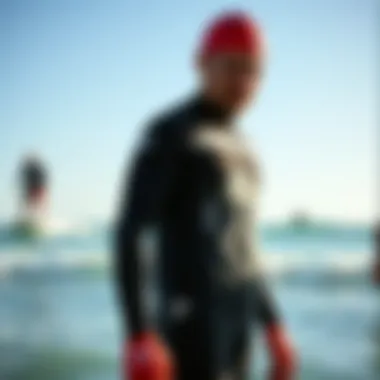
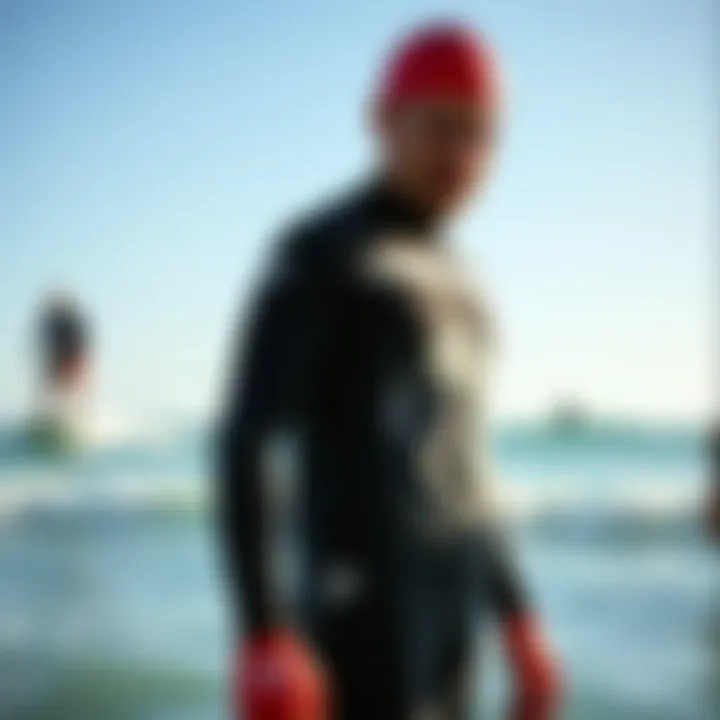
New Materials and Designs in Wetsuits
The introduction of new materials in wetsuit construction is a game-changer. For instance, many brands are pivoting towards eco-friendly neoprene alternatives, such as limestone-based neoprene or Yulex, which reduce the environmental footprint of wetsuit production without sacrificing quality. This shift not only addresses sustainability concerns but often results in suits that are lighter and more durable, leading to improved performance.
Beyond the fabric itself, innovative designs are emerging that focus on fit and comfort. Consider the "diagonal chest zip" design that many newer wetsuits feature. This design provides easier entry and exit while minimizing water intrusion, ensuring fewer distractions and a more enjoyable experience for the kiteboarder.
Moreover, glued and blind-stitched seams are gaining traction. They offer superior insulation and flexibility compared to traditional flat-lock seams. This construction technique prevents water from seeping in, which is vital for maintaining body temperature during those cooler sessions. In essence, the ongoing improvements in materials and designs serve not just to keep kiteboarders warm, but also to enhance their mobility and overall experience on the water.
Advancements in Drysuit Technology
When it comes to drysuits, the technology has come leaps and bounds. The focal point here is on waterproofing solutions and the materials used to construct these suits. For instance, advanced breathable fabrics such as GORE-TEX or similar proprietary blends allow moisture from perspiration to escape while keeping water out. This means that kiteboarders can enjoy longer sessions without the discomfort of overheating inside their suits.
Seals and zippers have also seen significant technological upgrades. The use of latex and neoprene seals around the wrists and neck minimize water ingress, creating a secure barrier that offers peace of mind for the rider. It’s no longer just about keeping the water out; it’s about ensuring the suit remains comfortably snug without causing constriction.
In addition, some drysuits now feature built-in inflation systems, allowing the wearer to adjust buoyancy while in the water. This is a crucial advancement for kiteboarders who may find themselves in conditions where managing buoyancy can make all the difference between a successful session or an unwanted tumble.
Ultimately, staying informed about technological innovations is essential for kiteboarders aiming to maximize their performance and enjoyment. By understanding how the latest materials and design advancements can impact their experience, they can make informed choices that align with their riding style and conditions.
Environmental Impact
In today’s world, where climate and environmental issues are at the forefront, understanding the environmental impact of our gear, including wetsuits and drysuits, is crucial for kiteboarders. These garments, essential for water sports enthusiasts, can have both positive and negative effects on the ecosystems we cherish. Awareness of these impacts not only helps individuals make informed choices but also encourages manufacturers to adopt more sustainable practices.
The conversation around environmental impact involves several elements. For instance, the materials used in the production of wetsuits and drysuits can either help or hinder our planet's health. As kiteboarders, we often find ourselves surrounded by nature's beauty while enjoying our sport; thus, it is vital to ensure that our equipment upholds the same respect for the environment. Here are some key considerations:
- Material Sourcing: The origins of neoprene and other materials matter. Are they derived from sustainable practices, or do they contribute to pollution and depletion of resources?
- Manufacturing Processes: How are wetsuits and drysuits made? Are factories adhering to eco-friendly practices that minimize waste and emission?
- End-of-Life Disposal: The lifecycle of these products is critical. Do we have options for recycling or properly disposing of them, or do they simply add to landfill waste?
These questions lead us to explore the innovations in sustainable practices within the industry, encouraging kiteboarders to not only enjoy their sport but also to partake in its preservation.
Sustainability in Wetsuit Production
Sustainability in wetsuit production takes center stage as manufacturers respond to the rising demand for eco-friendly options. Traditional wetsuits made from neoprene, a petroleum-based product, pose significant challenges in terms of carbon footprint and environmental degradation. However, companies are stepping up to the plate. For example, brands like Patagonia have begun using a type of natural rubber from rubber trees, which not only reduces reliance on fossil fuels but also minimizes harmful emissions during production.
When considering sustainability practices, here are some points worth noting:
- Biodegradable Materials: Innovations are making wetsuits with materials that break down more easily, reducing long-term waste.
- Eco-Friendly Manufacturers: Some companies have committed to sustainable practices across their entire operation— from product design to shipping.
- Recycling Programs: Initiatives that encourage customers to return old wetsuits for recycling can significantly reduce waste, allowing materials to be reused rather than tossed aside.
In this way, kiteboarders can make not only functional choices but also ethical ones.
Eco-Friendly Drysuits
Just as with wetsuits, eco-friendly options are becoming available in the drysuit sector. These suits, traditionally made with synthetic materials such as waterproof nylon or PVC, have advantages in cold weather, yet they, too, contribute to environmental concerns. Transporting the notion of sustainability to drysuits requires innovation and consciousness.
Here are a few advancements that highlight eco-friendly practices in drysuit construction:
- Sustainable Fabrics: Like wetsuits, drysuits are now being crafted with materials that incorporate recycled components, reducing the use of virgin plastics.
- Durability: Extended durability in materials means that the suits need to be replaced less frequently, which inherently minimizes waste.
- Low-Impact Production Techniques: Companies are refining their manufacturing processes to lower energy consumption and carbon output.
Incorporating these eco-friendly practices into drysuit production is vital for protecting the environments kiteboarders love. Ultimately, both wetsuits and drysuits have a responsibility to balance performance with ecological soundness, making it imperative for consumers to choose wisely.
"By prioritizing sustainability in gear choices, we can preserve the waters we kiteboard on for generations to come.”
In summary, kiteboarders are not merely athletes; they are stewards of the beautiful waters they ride on. By recognizing the environmental impact, embracing sustainable practices in wetsuit and drysuit production, the community can become a driving force towards a healthier planet.
Personal Stories and Testimonials
The realm of kiteboarding is not just about harnessing the wind and riding the waves; it's also heavily steeped in personal tales and shared experiences from the community. That’s where personal stories and testimonials come into play. This section aims to highlight the significance of these narratives, showcasing how they provide valuable insights into the realities of using wetsuits and drysuits during kiteboarding adventures.
Personal anecdotes from fellow kiteboarders can enlighten newcomers and seasoned enthusiasts alike, offering unique perspectives that can't always be found in guides or manuals. Often, these stories provide reasons for choosing one suit over another based on individual experiences with varying water conditions, and they encompass the trials and triumphs faced by kiteboarders.
- Real-life applications: Understanding how different suits behave in real conditions can help inform purchasing decisions. A story about a last-minute trip, where a wetsuit proved invaluable in unexpectedly chilly waters, might nudge someone undecided about an investment.
- Inspiring confidence and trust: Hearing from peers, the community, helps kiteboarders connect. Authentic testimonials create a sense of reliability and often paint a more vivid picture of a suit’s performance compared to marketing materials.
- Broader perspective: These tales extend beyond mere functionality; they highlight the emotional and experiential aspects of kiteboarding. A story about a first-time experience, where a drysuit made all the difference, can resonate deeply and motivate others to embark on their own journeys.
"When you hear about someone who battled through rough waters with their trusty suit, it’s not just about gear; it’s about the thrill, the challenge, and that sense of achievement,
Culmination and Recommendations
As we wrap up this comprehensive analysis of wetsuits and drysuits, it’s paramount to recognize the role these suits play in the kiteboarding experience. Choosing the right suit isn’t just about comfort; it’s a matter of performance, safety, and enjoyment on the water. Kiteboarders, whether seasoned or novice, can greatly benefit from understanding the nuances of both wetsuits and drysuits.
Final Thoughts on Wetsuits
Wetsuits, crafted primarily from neoprene, offer warmth by trapping a thin layer of water between the suit and the skin. This layer warms up with body heat, providing insulation essential for cooler water sessions. When picking a wetsuit, consider factors such as thickness, fit, and flexibility. A suit that’s too loose will let in cold water, while one that’s too tight can restrict movement. Different styles, like full suits or shorties, cater to varying weather and water conditions.
Regular care is also crucial. Washing your wetsuit after each session helps preserve its lifespan. Make sure to hang it in the shade, as direct sunlight may degrade the material over time.
Maintaining these practices not only keeps you comfortable but also enhances your performance on the water. Reliable protection against both cold and abrasions leads to a more enjoyable ride.
Summation of Drysuit Benefits
On the flip side, drysuits provide an entirely different set of advantages. Unlike wetsuits, drysuits are designed to keep you completely dry by using waterproof materials and seals. This is particularly significant in extremely cold conditions where staying dry can prevent hypothermia.
Drysuits offer ventilation options, allowing for some moisture escape, which is beneficial during active sessions. Their versatility makes them suitable for various activities, including kiteboarding, sailing, and kayaking. When selecting a drysuit, look for features like adjustable cuffs, waterproof zippers, and built-in insulation, which can significantly enhance thermal regulation and comfort.
"The right piece of gear can be the difference between a good session and a great one. Make your choice count."
For further insights into appropriate gear and care techniques, consider resources from the American Kiteboarding Association (https://aka.i-kite.org) or local kiteboarding clubs that often provide valuable firsthand knowledge and recommendations.







